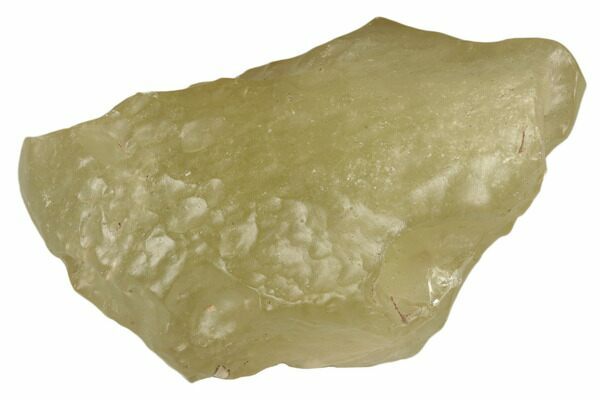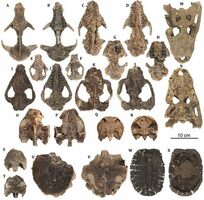Libyan Desert Glass: The Saharan Treasure With Interstellar Origins
Since its official discovery in 1932, scientists have always been fascinated by Libyan Desert Glass, an impactite/tektite that should have rather straightforward origins. Over the years a slough of theories were thrown around regarding Libyan Desert Glass origins, but only two percolated to the top of the pile. Ironically, though unsurprisingly, the two prominent theories took opposite approaches. One camp argued for a slow-cooling glass origin story and the other was adamant that Libyan Desert Glass was created via meteorite impact, or at the very least, a cataclysmic event that produced the massive amounts of heat required to turn sand into glass.
The slow-cool theory was based upon studies done in 1983 and 1984 which pointed to fossiliferous rock inclusions and higher water content than had previously been measured in other impactites. In addition, and this was a major piece of the slow-cool argument, there wasn’t a crater present that was big enough to be responsible for the distribution and amount of Libyan Desert Glass that was observed. However, much of the scientific community remained adamant that Libyan Desert Glass was the result of a titanic impact.
In 1996, a team of researchers led by Christian Koeberl, conducted comprehensive studies on the chemical composition of Libyan Desert Glass. An additional goal of the study was to locate the definitive area of impact using comparative analysis of samples from two nearby craters. The study used a variety of methods including electron microprobe analyses and instrumental neutron activation analysis. The primary findings of this study illuminated two major components that would eventually point researchers toward the current conclusion of Libyan Desert Glass origins.
The two components that supported the impact origin theory are the minerals, lechatelierite and baddeleyite. Lechatelierite is a transitional product of quartz when melted at high temperatures and baddeleyite is a breakdown product of zircon. Both of these minerals were found in high abundance within the Libyan Desert Glass samples and both only occur at extremely high temperatures. We are talking about temperatures in the ballpark of 1,600° C (2,912° F), which is easily in excess of the hottest geologic environments on earth. At the time of this study, that was enough for Koeberl to reasonably embrace an impact origin over low temperature cooling. As far as crater rock material comparison goes, the study found similarities in rock composition at impact sites, though no definitive match for Libyan Desert Glass's crater of origin. Much of the similarity was disregarded because of the homogeneity of the geologic material in the surrounding desert.
Another study in 1996 was able to determine the age of Libyan Desert Glass using fission-track dating. This is the most accurate method of radiometric dating in minerals and glasses that have undergone extreme conditions; a method that measures “heat damage” on the material to reasonably determine age. These researchers discovered that Libyan Desert Glass is roughly 27 million years old, plus or minus 2 million years. Most scientists agree that 29 million years old is an acceptable estimate.
In the years following the findings from 1996, scientists hemmed and hawed over whether or not Libyan Desert Glass was the result of a meteorite impact, mainly because there was no definitive point of impact. It was the scientific equivalent of, “If it doesn’t fit, you must acquit.” There was a relative lull in studies, until 2013 when a massive airblast struck a town in Russia. Now scientists had an interesting new angle to pursue. An airblast is an explosion in space near earth’s atmosphere, usually caused by the collision of interstellar bodies that sends a pressure wave hurtling at the earth. Scientists conjectured that Libyan Desert Glass was the result of an extremely large airblast, roughly 100 megatons. The sheer amount of pressure and the coinciding heat may have been enough to superheat the sand in the Sahara and form Libyan Desert Glass. Even better, this theory offers an explanation for the lack of a crater where the glass is found.
At long last, an article published in 2019 by Aaron Cavosie and Christian Koeberl provides new evidence in this near decade-long mystery. After extensive analysis, this research team has discovered that Libyan Desert glass was indeed created by meteorite impact. This finding was discovered via good, old-fashioned chemistry.
Libyan Desert glass has a very high zircon content, and when under extreme temperature and pressure zircon can transform into a different mineral, reidite. These temperatures are typically only achieved in a cataclysmic event such as a meteorite impact. Reidite (which is a very rare mineral) forms at the moment of impact, but is very unstable and will revert back to zircon when it reaches too high of a temperature. However, when reidite forms it creates a directional shift in its crystal structure that is different from zircon’s. This shift leaves measurable traces of the change. When zircon is tested, via a method called backscatter diffraction, evidence of reidite becomes apparent. The temperature required to initiate this transformation from zircon to reidite and back to zircon could only be achieved by a meteorite impact, and not the pressure wave of an airblast. For now, this theory has been enough to quell most naysayers about an impact creation theory. With the exception of a few loose threads.
Only by tenacious experimentation and diligent research will we be able to answer the remaining questions about Libyan Desert Glass. Such as, why haven’t scientists been able to uncover the location of the impact crater? Most likely because of erosion under hostile desert conditions, where then is the evidence of erosion? The size of the crater is also an unknown in the mystery of Libyan Desert Glass, which is impressive considering that the glass has only been collected within a 6,500 kilometer radius. Despite these missing pieces, the reidite evidence is a fascinating discovery that helps paint a more complete picture of an enigmatic impactite. Until the next major breakthrough we can rest a bit easier knowing that we can keep calling Libyan Desert Glass an Impactite.
The slow-cool theory was based upon studies done in 1983 and 1984 which pointed to fossiliferous rock inclusions and higher water content than had previously been measured in other impactites. In addition, and this was a major piece of the slow-cool argument, there wasn’t a crater present that was big enough to be responsible for the distribution and amount of Libyan Desert Glass that was observed. However, much of the scientific community remained adamant that Libyan Desert Glass was the result of a titanic impact.
Close, But No Cigar - Mid 1990’s Research
In 1996, a team of researchers led by Christian Koeberl, conducted comprehensive studies on the chemical composition of Libyan Desert Glass. An additional goal of the study was to locate the definitive area of impact using comparative analysis of samples from two nearby craters. The study used a variety of methods including electron microprobe analyses and instrumental neutron activation analysis. The primary findings of this study illuminated two major components that would eventually point researchers toward the current conclusion of Libyan Desert Glass origins.
The two components that supported the impact origin theory are the minerals, lechatelierite and baddeleyite. Lechatelierite is a transitional product of quartz when melted at high temperatures and baddeleyite is a breakdown product of zircon. Both of these minerals were found in high abundance within the Libyan Desert Glass samples and both only occur at extremely high temperatures. We are talking about temperatures in the ballpark of 1,600° C (2,912° F), which is easily in excess of the hottest geologic environments on earth. At the time of this study, that was enough for Koeberl to reasonably embrace an impact origin over low temperature cooling. As far as crater rock material comparison goes, the study found similarities in rock composition at impact sites, though no definitive match for Libyan Desert Glass's crater of origin. Much of the similarity was disregarded because of the homogeneity of the geologic material in the surrounding desert.
Another study in 1996 was able to determine the age of Libyan Desert Glass using fission-track dating. This is the most accurate method of radiometric dating in minerals and glasses that have undergone extreme conditions; a method that measures “heat damage” on the material to reasonably determine age. These researchers discovered that Libyan Desert Glass is roughly 27 million years old, plus or minus 2 million years. Most scientists agree that 29 million years old is an acceptable estimate.
Getting There... - A New Theory Emerges
In the years following the findings from 1996, scientists hemmed and hawed over whether or not Libyan Desert Glass was the result of a meteorite impact, mainly because there was no definitive point of impact. It was the scientific equivalent of, “If it doesn’t fit, you must acquit.” There was a relative lull in studies, until 2013 when a massive airblast struck a town in Russia. Now scientists had an interesting new angle to pursue. An airblast is an explosion in space near earth’s atmosphere, usually caused by the collision of interstellar bodies that sends a pressure wave hurtling at the earth. Scientists conjectured that Libyan Desert Glass was the result of an extremely large airblast, roughly 100 megatons. The sheer amount of pressure and the coinciding heat may have been enough to superheat the sand in the Sahara and form Libyan Desert Glass. Even better, this theory offers an explanation for the lack of a crater where the glass is found.
Bingo! - Latest Findings
At long last, an article published in 2019 by Aaron Cavosie and Christian Koeberl provides new evidence in this near decade-long mystery. After extensive analysis, this research team has discovered that Libyan Desert glass was indeed created by meteorite impact. This finding was discovered via good, old-fashioned chemistry.
Libyan Desert glass has a very high zircon content, and when under extreme temperature and pressure zircon can transform into a different mineral, reidite. These temperatures are typically only achieved in a cataclysmic event such as a meteorite impact. Reidite (which is a very rare mineral) forms at the moment of impact, but is very unstable and will revert back to zircon when it reaches too high of a temperature. However, when reidite forms it creates a directional shift in its crystal structure that is different from zircon’s. This shift leaves measurable traces of the change. When zircon is tested, via a method called backscatter diffraction, evidence of reidite becomes apparent. The temperature required to initiate this transformation from zircon to reidite and back to zircon could only be achieved by a meteorite impact, and not the pressure wave of an airblast. For now, this theory has been enough to quell most naysayers about an impact creation theory. With the exception of a few loose threads.
Keep On Trekking - Moving Forward with Libyan Desert Glass
Only by tenacious experimentation and diligent research will we be able to answer the remaining questions about Libyan Desert Glass. Such as, why haven’t scientists been able to uncover the location of the impact crater? Most likely because of erosion under hostile desert conditions, where then is the evidence of erosion? The size of the crater is also an unknown in the mystery of Libyan Desert Glass, which is impressive considering that the glass has only been collected within a 6,500 kilometer radius. Despite these missing pieces, the reidite evidence is a fascinating discovery that helps paint a more complete picture of an enigmatic impactite. Until the next major breakthrough we can rest a bit easier knowing that we can keep calling Libyan Desert Glass an Impactite.
 Reviews
Reviews






